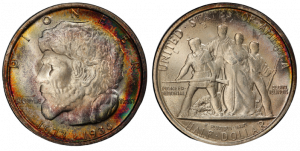1936 Elgin Half Dollar
Posted on — 2 CommentsThe Elgin Illinois Centennial half dollar honors the founding pioneers of Elgin, Illinois located 30 miles west of Chicago. Founded in 1835, the area eventually became a village by 1847, then finally a city in 1854.

The first person to suggest commemorating the town was Trygve Rovelstad, the son of Norwegian immigrants in the U.S. As a sculptor, he decided that he would erect a statue in Elgin to remember the pioneers that settled the town. He eventually got approval from city officials and prepared a foundation for the statue in 1934. However, not long after, Rovelstad ran into financing problems and was unable to generate the money needed. Then he had an idea.
Rovelstad decided that he could raise the money through the issuance of a commemorative coin. In 1935, he arranged for a bill to be introduced to Congress authorizing a half dollar that would commemorate Elgin’s centennial. Again, Rovelstad ran into problems, as the bill was not considered.
That same year, Rovelstad met Lyman W. Hoffecker, a coin dealer from El Paso, Texas who had learned of the bill and took an immediate interest in the project. Hoffecker offered guidance on how to earn approval from Congress. Importantly, he also offered to handle the distribution of the coins. Determined to make these coins a reality, Hoffecker didn’t reveal to Rovelstad that he was a coin dealer and even warned him in a letter that “it would not be good for either of us if the word got out you had disposed of the entire issue to me.”
By the end of 1935, Hoffecker offered to pay the Elgin committee $12,000 and sell the coins for $2.00 each. He offered to advance the Mint the face value of the coins while also covering engraving and shipping charges.
The collaboration between Rovelstad and Hoffecker was finally enough to get the bill passed and signed by President Roosevelt in 1936. The mint quantity was set at 25,000 coins and would be paid for by the Elgin committee. The Philadelphia Mint handled the issuance and, by the end of 1936, they had struck all 25,000 pieces.
The obverse of the coin shows the profile of a pioneer and the reverse shows a group of four adult pioneers and a baby in its mother’s arms. The reverse image was, in fact, a bas relief of the model that Rovelstad originally intended for his statue. This image also appeared on the medal Rovelstad designed for Elgin’s centennial along with the words “to the men who have blazed the trails, who have conquered the soil, and who have built an empire in the land of the Illini.” The final design of the coin included “Elgin, Illinois” at the suggestion of Hoffecker.
As planned, Hoffecker sold the coins directly to collectors at the issue price rather than to speculators or dealers. Ultimately, he was able to sell about 20,000 of the total minting, with the remaining coins being returned to the Mint for melting.
In the end, Rovelstad was successful, though he did not live to see his final work. In 2001 his memorial was completed. It was all possible due to the popularity of the Elgin half dollar.
Want to read more? Subscribe to the Blanchard Newsletter and get our tales from the vault, our favorite stories from around the world and the latest tangible assets news delivered to your inbox weekly.
2 thoughts on “1936 Elgin Half Dollar”
Comments are closed.








Are these coins ever for sale?
We do have an Elgin on the site right now and you can find it here – https://www.blanchardgold.com/shop/rare-coins/?filter_product-wu-code=450-080#
Feel free to give us a call if you have any questions at all.